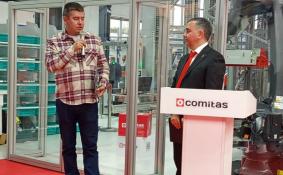Scientific & Practical Journal

Editorial News
Dear readers! We are pleased to present to you the eleventh issue of the journal in 2025. There are a lot of relevant and useful materials in the issue, which, hopefully, will not be ignored.
Dear readers! In September the CeMAT RUSSIA exhibition was held, which showed everyone that innovations and robotics are increasingly penetrating the logistics industry. We can safely say that many technologies are tested here, and only then they go out into the world. However, it is not only CeMAT RUSSIA that demonstrates the prevalence of the digital agenda.
Dear readers! This is the ninth issue of the journal, which turned out to be very rich and diverse. Traditionally, the issue is opened by an analyst. The material by Alina Nasyrova from the Market Guide Agency, dedicated to investments in warehouse complexes in Russia, recalls the importance of developing logistics infrastructure for the integrated development of regions.
PHOTO OF THE WEEK
CITATIONS
«Logistics» Journal № 6 / 2015
EVENTS
Market Guide Agency predicts an increase of 2.7–3.0% in freight traffic on the territory of Saratov Region from 2016 to 2025
MARKET ANALYSIS
Forecasts of the economic landscape and the impact of the crisis on the development of logistics in Russia
INFRASTRUCTURE
Modeling of warehouse infrastructure for regions of the Russian Federation
This paper describes the approach of modeling a regional warehouse infrastructure taking major social and economic indicators into account. The methodology enables to consider delivery of various goods by different means. The proposed approach determines optimal geographic location and capacity for each of warehouses in a backbone network in a given region of the Russian Federation.
Key words. General use warehouse, warehouse infrastructure modeling, backbone warehouse network.
INFORMATION TECHNOLOGIES
RFID- technology in the Russian logistics: real achievements and challenges
We consider the problems of relevance and use of modern informational and communicational technologies in the Russian logistics, advantages and limitations of using RFID (radio frequency identification) in the domestic business, reasons for slow implementation and the prospects for RFID according to survey of directors of leading Russian logistics companies.
Key words. Logistics, RFID, supply chains.
TRANSPORT. TRANSPORTATION
Actual status, competitiveness and operational problems of Trans-Siberian Railway (“Transsib”)
Trans-Siberian railway connects Russian western, northern, southern ports and European railway outlets with Pacific ports and Asian railway outlets. Transit traffic between Europe and South East Asia is increasing. Therefore, development of a land bridge from South Korea to Western Europe via Russia comes into importance. Trans-Siberian railway is actually existing transport corridor. It passes through the Russian area and capable to meet the needs of the Eurasian cargo companies.
Key words. Trans-Siberian railway, transit freight traffic, cargo traffic, competitive performance of transport corridor “Transsib”.
EDUCATION. PERSONNEL
System of higher education of logistics in St. Petersburg (Part I)
An article discusses the changes in higher education in the field of logistics upon transition to the Bologna system. It identifies key issues in personnel training of logistics. Statistical data on labor market in the area of supply chain management and logistics are provided.
Key words. Logistics, higher education, labor market.
SUPPLY CHAIN MANAGEMENT
Making of integrated informational support solutions in sphere of logistics and supply chain management
An article reviewed basic stages of formation and configuration of integrated modular structure to support the logistics and supply chain management (SCM). It sets requirements for project structure of the corporate information systems (CIS) which integrates and supports logistics business processes in supply chains. Implementation of an integrated IT-support of logistics and SCM on basis of ERP/SCM systems exemplified by the company Generix.
Key words. Logistics, supply chain management, integrated informational support, ERP/SCM systems, modular structure.
The author considers the issues related to the study of supply chain, introduces a new concept (“fragmentogram”), discloses its economic nature.
Key words. Fragmentogram, logistical barrier, supply chain.
PROBLEMS AND OPINIONS
The logistic management features of trans-border high-tech products flows (Part I)
An article analyses logistic management features of trans-border high-tech product flows under imperative restricts by the system of state regulating in the field of foreign economic activity.
Key words. High-tech products, trans-border flows, logistic management, customs control, export control.













